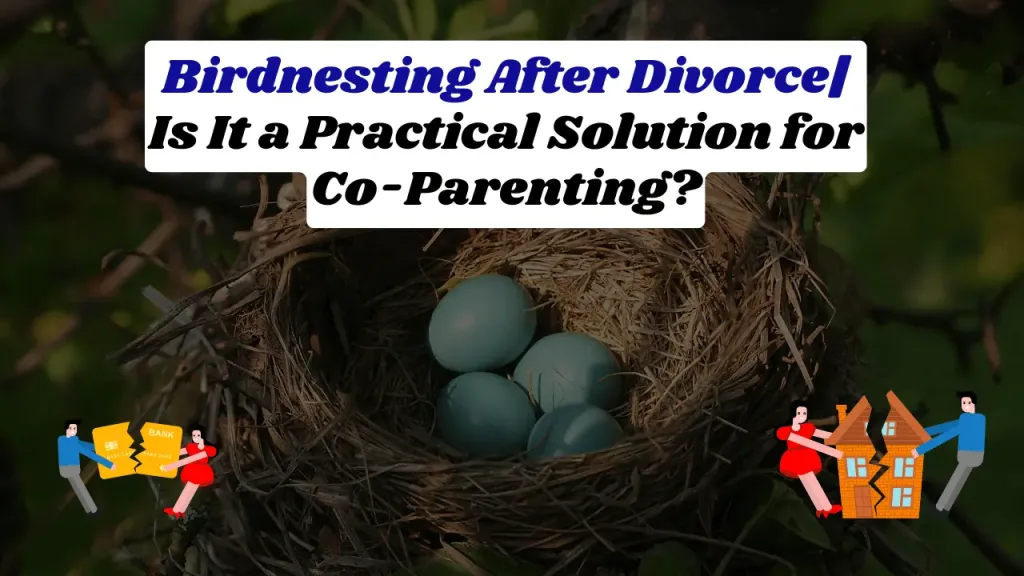Birdnesting After Divorce| Is It a Practical Solution for Co-Parenting?
Divorce is one of the most stressful events a family can go through, and it can have significant effects on the emotional and mental well-being of children. One of the most common challenges after a divorce is co-parenting—especially when it comes to living arrangements for children. To address this, many parents are turning to an innovative co-parenting strategy called birdnesting, which involves children staying in the family home while parents rotate in and out of the home. But is it a practical, sustainable solution for families? In this article, we explore the concept of birdnesting, its benefits for children, financial aspects, psychological considerations, and the challenges involved.
What is Birdnesting?
Birdnesting is a co-parenting arrangement where children continue to live in the family home after their parents divorce, while the parents alternate in and out of the house. In other words, the children stay put, and the parents take turns living in the family home while maintaining separate residences when they are off-duty.

The term “birdnesting” is inspired by the behavior of birds, which alternate in and out of the nest to care for their young. This strategy is designed to minimize upheaval in the children’s lives, providing them with continuity during an emotionally challenging time. Research has shown that stability is crucial for children after a divorce—children who experience fewer disruptions in their environment tend to fare better emotionally and academically. According to a study from the American Psychological Association (APA), children of divorced parents who experience a stable living situation (such as birdnesting) tend to exhibit less anxiety and improve emotionally compared to children who have to move between multiple homes.
In fact, studies show that 68% of children in stable, single-household environments following divorce show fewer behavioral problems compared to children who have to shuttle between two homes. Birdnesting aims to replicate that stability.
Table of Contents
Benefits for Children
The primary benefit of birdnesting for children is stability. During a divorce, children are often forced to navigate significant disruptions in their lives—moving between two homes, adjusting to new schedules, and dealing with emotional challenges. Birdnesting helps to reduce these changes by allowing children to remain in one familiar environment. A survey conducted by the National Parents Organization found that 60% of children reported feeling anxious or stressed about having to adjust to life in two different households.
In a birdnesting arrangement, children remain in the same home, attend the same school, and maintain their social lives and friendships without the added stress of constantly moving between two houses. A report from the University of Melbourne found that children who stay in their original home following a divorce experience better mental health outcomes and stronger academic performance than those who are forced to adapt to new environments.
Additionally, children benefit from having both parents involved in their daily lives. In traditional custody arrangements, children might feel torn between two households, but birdnesting provides a smoother transition as parents share equal responsibilities in the home. This continuity helps children feel more secure and emotionally supported.
According to the American Academy of Child and Adolescent Psychiatry, stability during times of family upheaval can reduce emotional distress and help children adjust more easily to their new family structure. Delaying a permanent change of homes also gives children time to process the separation gradually.
Financial and Logistical Aspects
While birdnesting offers clear benefits for children, it does come with its own set of financial and logistical challenges. One of the primary issues is the cost. Maintaining the family home while also keeping separate residences for each parent can be expensive. According to a 2022 survey by Divorce Financial Analysis, 35% of parents said the high costs of maintaining both a family home and separate living arrangements were a significant downside of birdnesting.
However, in some cases, the arrangement can provide financial relief in the short term. Parents may be able to save money by delaying the need to sell the family home or rent two separate apartments immediately after the divorce. Shared costs, like utilities and maintenance of the family home, may also be divided between the parents, reducing the financial burden on both.
On the other hand, this setup can strain the parents’ finances in the long run, especially if the arrangement continues for an extended period. 55% of parents in a study by the Journal of Divorce and Remarriage reported facing financial strain when birdnesting continued for over a year. It is crucial for parents to have clear financial agreements in place regarding the costs of the family home and additional accommodations. Establishing these guidelines can help avoid misunderstandings and conflict.
Additionally, logistical issues such as scheduling the time each parent spends in the family home need to be clearly defined. Conflict resolution between parents becomes key—particularly when both need to respect each other’s space and privacy while rotating in and out of the home.
Psychological and Emotional Considerations
While birdnesting has numerous advantages for children, it can also have psychological and emotional effects on both children and parents. On the one hand, some experts believe that it can help children feel emotionally secure during a period of significant change. 72% of parents who use birdnesting believe it reduces emotional distress for their children, according to a report from the National Parents Organization.
However, there are potential drawbacks. Some children may become confused about the permanence of their parents’ separation if they continue to live in the same home. A study from the University of California found that 43% of children in birdnesting arrangements reported feeling uncertain about whether their parents might reconcile, leading to emotional confusion.
For parents, birdnesting can be a double-edged sword. It may provide some emotional relief and allow them time to focus on personal matters, but living in the same home as an ex-spouse can also create tension and difficulty moving forward emotionally. According to a 2021 study by the Journal of Divorce and Remarriage, 45% of parents stated that living with their ex-partner during the birdnesting arrangement made it harder for them to form new relationships or emotionally disconnect from their past marriage.
Related Articles For You:
Cohabitation Rights in the UK | What Unmarried Couples Need to Know
Ultimate Guide to Pension Sharing Orders in Divorce
Challenges for Parents
Birdnesting is not without its challenges for the parents involved. One of the most important factors for success is communication. Parents must be able to discuss and agree on the details of the arrangement, including who stays in the family home and when, how they will share parenting responsibilities, and how they will manage household chores.
Setting clear boundaries is essential to prevent issues arising when one parent begins a new relationship or if the structure of the arrangement is not respected. For example, parents need to agree on whether overnight guests are allowed during their time away from the family home. Conflict can also arise if parents have differing views on how to approach discipline, schoolwork, or general family life.
As the arrangement continues, parents may find it difficult to move on emotionally from their previous relationship. This can result in tension or resentment, making it harder for parents to maintain a peaceful and cooperative environment. It can be hard for parents to establish personal lives, especially when they are living in close proximity to their ex-spouse.
Legal Considerations
Legal agreements are crucial to making a birdnesting arrangement work. Parents must establish clear terms regarding custody schedules, the division of household duties, and financial responsibilities. Without legal agreements, disputes over these matters could escalate into conflict.
One of the key legal aspects is the Child Arrangement Order (CAO), which helps parents formalize the birdnesting arrangement. CAOs outline how parents will share custody and care for their children and can be used to address financial responsibilities, such as the cost of maintaining the family home. In some cases, parents may also include restrictions on overnight guests to avoid complications if one parent begins a new relationship.
It’s important to remember that courts always prioritize the best interests of the child, and will only approve a birdnesting arrangement if they believe it will benefit the child. Disagreements may arise, but the focus remains on ensuring a stable and safe environment for the children involved.
Cultural Context and Growth of the Trend
Birdnesting, though a relatively modern approach to co-parenting, has its roots in Sweden, where it was initially popularized. Over the years, the trend has gained traction in Western countries, especially in the United States and the UK, as more divorced parents seek solutions that prioritize the well-being of their children.
The popularity of birdnesting has been significantly bolstered by media portrayals in television shows and movies. For example, shows like “Splitting Up Together” and “Billions” have featured birdnesting arrangements, bringing it into the mainstream and prompting discussions about whether it could be a viable solution for real-life families. High-profile figures like Gwyneth Paltrow have also publicly discussed their use of birdnesting arrangements, further highlighting the concept’s potential.
Pros and Cons of Birdnesting
Pros
- Stability for Children: The primary benefit is that children stay in the family home, maintaining stability and routine.
- Reduced Stress: Children don’t have to shuttle between two homes, minimizing disruption to their lives.
- Better Mental Health Outcomes: Studies show children in stable environments post-divorce experience fewer emotional and academic struggles.
- Shared Parenting Responsibilities: Parents share the caregiving role equally, providing balanced involvement in children’s lives.
Cons
- Financial Strain: Maintaining two households, including the family home, can be expensive.
- Emotional Confusion for Children: Some children may struggle with the idea that their parents are still sharing a home, even if they are divorced.
- Difficulties Moving On: Parents may find it emotionally difficult to adjust to a new life while still living together in close proximity.
- Logistical Challenges: Setting up schedules and clear boundaries can be difficult and require significant cooperation.
Conclusion
Birdnesting can be a practical solution for some families navigating the challenges of co-parenting after divorce. It offers significant benefits for children, especially in terms of emotional stability and continuity. However, it is not without its challenges, including financial strain, emotional complications, and logistical difficulties.
Parents considering birdnesting should weigh the pros and cons carefully, considering their financial situation, the emotional needs of their children, and their ability to communicate effectively. If done with clear agreements, mutual respect, and cooperation, birdnesting can be a temporary solution that helps children adjust more smoothly to life after divorce. For some families, it may even evolve into a more permanent co-parenting arrangement. Ultimately, birdnesting is a family-specific solution that requires open communication, understanding, and legal considerations to work effectively.
About the Author

Sarah Klein, JD, is a former family law attorney with over a decade of courtroom and mediation experience. She has represented clients in divorce, custody cases, adoption, Alimony, and domestic violence cases across multiple U.S. jurisdictions.
At All About Lawyer, Sarah now uses her deep legal background to create easy-to-understand guides that help families navigate the legal system with clarity and confidence.
Every article is based on her real-world legal experience and reviewed to reflect current laws.
Read more about Sarah
